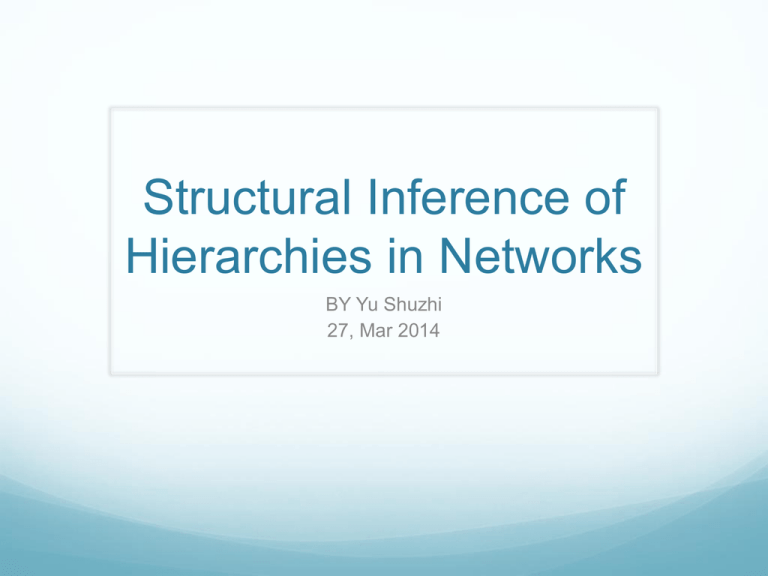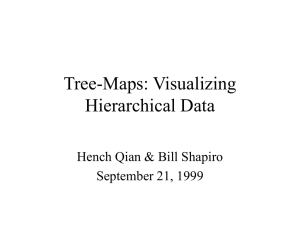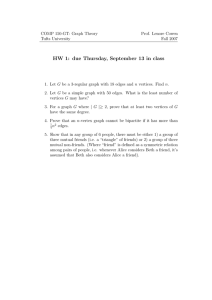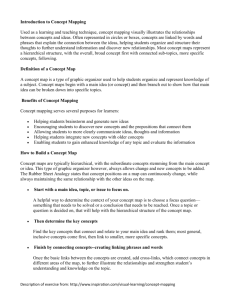ShuZhi's slides
advertisement

Structural Inference of Hierarchies in Networks BY Yu Shuzhi 27, Mar 2014 Content 1. Background 2. Hierarchical Structures 3. Random Graph Model of Hierarchical Organization 4. Consensus Hierarchies 5. Edge and Node Annotation 6. Prediction of Missing Interactions in Network 7. Testing 8. Work to do Background Network and graph is a useful tool for analyzing complex systems. Researchers try to develop new techniques and models for the analysis and interpretation of the network and graphs. Hierarchy is an important property of real-world networks, since it can be observed in many networks. Background Previously, Hierarchical Clustering algorithms are used to analyze the hierarchical structure. Choose a similarity measure method Compute similarity for each pair of vertices(n×n matrix) Identify groups of vertices with high similarity Agglomerative algorithms (iteratively merged) Divisive algorithms (iteratively split) Background Weakness of Traditional Hierarchical Clustering algorithms: The algorithm only provides a single structure It is unclear the result is unbiased. Hierarchical Structure Definition of Hierarchical Structure: It is one that divides naturally into groups and these groups themselves divide into subgroups, and so on until reaching the level of individual vertices. Representations: Dendrogram or Trees Example of dendrogram: leaves are graph vertices and internal vertices represent hierarchical relationships Random Graph Model Assumption: The edges of the graph exist independently but with a probability that is not identically distributed. The probability is represented asΘi. How to determineΘi: For a dendrogram, use the method of maximum likelihood to estimate Θi. Θi = E / (Li*Ri) Ei: the number of edges in graph that have lowest common ancestor i (the internal node) Li and Ri:number of leaves in the left- and right- subtree rooted at i. The likelihood for the dendrogram is: LH(D, Θ) = Πi=1n-1(Θi)Ei (1 – Θi) Li*Ri-Ei Random Graph Model How to find the dendrogram with the maximum likelihood: It is difficult to maximize the resulting likelihood. Employ a Markov Chain Monte Carlo (MCMC) method. The number of dendrograms with n leaves is super-exponential:(2n3)!!. However, in practice the MCMC process works relatively quickly for networks up to a few thousand vertices. Random Graph Model Markov Chain Monte Carlo sampling: Let v denote the current state (a dendrogram) of the Markov Chain. Each internal node I of the dendrogram is associated with three subtress: two are its children and one is its sibling. There are three configurations. a b c a b c a c b Each time for transition, choose an internal node randomly and then choose one of its two alternate configurations uniformly at random. For larger graphs, we can apply more dramatically change of the structure. We only accept a transition that yields an increase in likelihood or no change: Lμ >= Lv; otherwise, accept a transition that decreases the likihood with probability equal to the ratio of the respective state likelihoods: Lμ / Lv = elogLv logLμ Random Graph Model After a while, the Markov Chain generates dendrograms μat equilibrium with probabilities proportional to Lμ. Consensus Hierarchies The idea is : Instead of using one dendrogram to represent the hierarchical structure of the graph, we compute average features of the dendrograms over the equilibrium distribution of models. Method: Take the collection of dendrograms at equilibrium. Derives a majority consensus dendrogram containing only those hierarchical features that have majority weight. The weight here is represented by the likelihood of the dendrogram. Result: The resulting hierarchical structures is a better summary of the network’s structure. Some coarsening of the hierarchy structures are removed. Random Graph Model Examples: Original dendrogram consensus dendrogram Node and Edge Annotation Similar to the concept of consensus, we can assign majority-weight properties to nodes and edges. Through weighting each dendrogram at equilibrium by likelihood For node, measure the average probability that a node belongs to its native group’s subtree. For edge, measure the average probability that an edge exists. Benefits: Allow us to annotate the network, highlighting the most plausible features. Node and Edge Annotation Example: Annotated version: Line thickness for edges proportional to their average probability of existance Shape indicates group Shaded proportional to the sampled weight of their native group affiliation(lighter, higher probability) Prediction of Missing Interactions in Network Hierarchical decomposition method: Find those highly possible connections but unconnected in real graph. These connections are probably missed. Previous methods: Assume that vertices are likely to be connected if They have many common neighbors There are short paths between them They work well for strongly assortative networks, like citation and terrorist network. Not good for disassortative network, like food webs. Prediction of Missing Interactions in Network Hierarchical decomposition method works well for both assortative and disassortative networks. Testing Provided program: fitHRG: input a graph(edges list); Output Hierarchical Random Graph ConsensusHRG: input a dendrogram from fitHRG program Output Hierarchical Random Graph PredictHRG Input a graph(edges list) Output list of non-edges ranked by their model-averaged likelihood Benchmark Test program provides: Input a graph(edges list) A list of nodes and their membership for the micro-communities A list of nodes and their membership for the macro-communities Work to do Figure out how to convert dendrogram into group list Improve the algorithm and compare References A. Clauset, C. Moore, and M.E.J. Newman. In E. M. Airoldi et al. (Eds.): ICML 2006 Ws, Lecture Notes in Computer Science 4503, 1 - 13. Springer-Verlag, Berlin Heidelberg (2007). A. Clauset, C. Moore, and M.E.J. Newman. Nature 453, 98 - 101 (2008)




